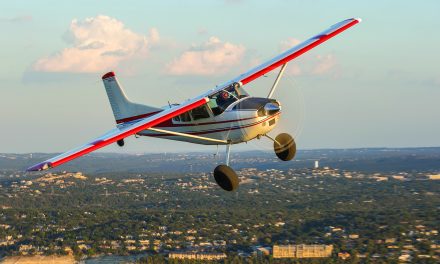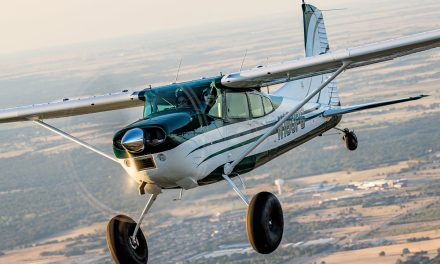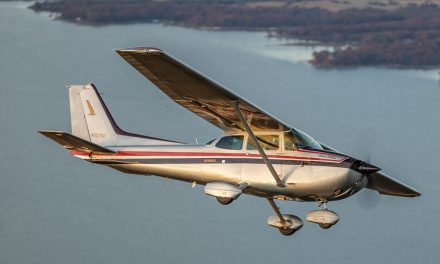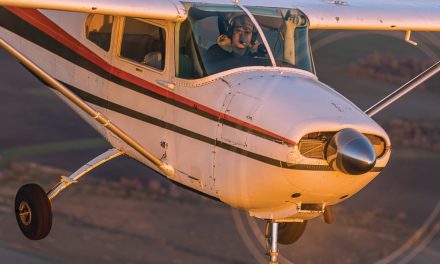A “New” and Improved 206
By Donna Jones – Davis Aviation
When the time came for Dave “Doc” Reise of Macon, Georgia, to make decisions about the future operation of his 1976 U206F, he did his homework. It was time for his annual, and he knew his tired IO-520 engine was reaching TBO. Along with making decisions about what to do with his engine, Doc thought about other updates the airplane needed. Doc, like every other pilot, had his “want” list.
With this list in mind, he researched the products available for his airplane. His planning and research started more than a year ago. Knowing his major undertaking would be the engine, he planned that around his annual. He would change out the engine and make the other improvements and updates to his aircraft at the same time.
He looked at different engine options available for his aircraft. A few years ago, he had replaced the propeller with a new Hartzell 80-inch three-blade Top Prop. His old threaded-hub McCauley propeller had reached TBO then. He had discovered the propeller was obsolete. Overhaul parts for his old propeller were difficult to find, as McCauley was no longer manufacturing them. Therefore, his best propeller replacement option was the Hartzell. When this particular propeller was chosen, it was with the knowledge that the versatility of the propeller would allow him to use it with the existing IO-520 engine, as well as with certain other engines, if he wanted to upgrade to a different engine at a later time.
For his 206, there were several engine options available. First, he determined the cost of installing another IO-520 engine. He then compared the standard IO-520 replacement to the engine upgrade options available for his aircraft. Over the last year, he had determined his options and studied what each one would do for his airplane, and the relative cost involved. Now that the decision needed to be made, he obtained current pricing on each option and made the decision. He had obtained details from various STC holders on a Teledyne Continental Motors IO-550 F installation, which offered 300 hp continuous. Additionally, there was a Teledyne Continental Motors IO-550 N installation (tuned-induction 310-hp engine) and the Soloy turbine conversion. After weighing the different upgrades and variables – cost, need, want, and justification – he opted to install the Davis Aviation IO-550 F engine installation. Many of you know this upgrade as the Bonaire 550. This STC installation has been around for more than 20 years. Doc told me that the Davis 550 suited his needs and would give his airplane the new life and performance he needed and wanted without breaking the bank. His propeller was not compatible with some of the other upgrade options. With the IO-550 F engine, he could use his existing propeller and keep the cost to a minimum while increasing the overall performance. I had to agree with his reasoning and explanation. I was pleased to be able to work with him.
Davis conversions were designed in the manner he described – prop first and engine later. You basically upgrade in installments. This is helpful, because the older McCauley threaded-hub propellers have been discontinued, and a prop replacement is often necessary before the engine is ready to change. This 550 installation also improves the aircraft safety and overall operation without major changes to the aircraft. In most cases, the installation is a drop-in-type, remove-and-replace (R & R) procedure with minor baffle modifications and a governor setting change. Safety and simplicity are key to helping the operator get the most for his money.
Under the cowling, the replacement of the alternator and propeller governor was a “need” for this aircraft. Some of the engine baffling and exhaust also needed replacement. Accessories are normally overhauled or replaced at the same time an engine is changed. Davis Aviation is a distributor for other aviation products and works with other STC holders. I have found that if the customer needs an engine replacement, chances are he will need accessory replacement, too. For customer convenience, Davis offers replacement options for some of these items the customer may need when they make an engine change.
In Doc’s case, Davis supplied a replacement Plane-Power alternator for the installation, as well as new engine baffle pieces and a new McCauley prop governor. He had trouble with his alternator in the past and was looking for a feasible alternative. He had replaced the existing alternator twice before. A new-design Plane-Power alternator was his choice. His old McCauley governor required service-bulletin updating, which would have cost nearly as much as a replacement. The 550 prop governor setting is different than the 520 setting but generally costs the same to convert as the standard overhaul. The shop will overhaul, reset to 2,700 rpm, and re-stamp to a different part number for the 550 installation. With this governor in need of expensive parts just to overhaul, it was more cost effective to buy a new one already set for the 550 installation. He opted for new baffle pieces from Airforms in Anchorage, Alaska. The company offers a complete PMA set of replacement engine baffling for the 206. His aircraft only needed a few replacement baffle pieces. The ones from Airforms were a good decision, being less expensive than the Cessna pieces with the same quality. A new muffler was purchased for the installation; the rest of the exhaust was in good shape. The standard items needed when making an engine change, such as new shock mounts, engine mount hardware, standard hoses firewall forward, alternator belt, and exhaust deflectors, also were purchased.
Nick Porcel of Lowe Aviation, who maintains N4561V, was prepared for this detailed project. Lowe Aviation is a full-service FBO located on the Middle Georgia Regional Airport (MCN) in Macon, Georgia. Not only is Lowe Aviation a FAA-certified repair station for aircraft maintenance and repairs, it provides avionics installation and repair. In addition, it offers aircraft sales, charter services, refueling services, and general assistance, such as hotel and rental car arrangements. It offers a wide range of needed services from any FBO. It has an excellent reputation for providing quality service in all aviation aspects provided. Scheduling of the aircraft in the hangar was set upon the engine order. Nick reviewed and confirmed everything that was planned for the aircraft, while Doc Reise ordered everything needed for the installation. As parts and items showed up at the shop, they were set aside until the engine arrived.
While the wait was on, other updates were performed. Replacement of the interior was another planned project. A new Airtex interior and carpet were installed. This was surely a nice change from the outdated 1970s blue seats and panels. The 206 was put in a friend’s hangar, where everything could be laid out and installed without rush. Bill Rogers, a retired fireman, whose family owns a local upholstery shop, helped get the new interior and carpet installed. Bill is an expert fabricator and refurbishes show cars and trucks in his spare time. Doc told me it was nice to have friends like Bill. Not only was he meticulous, his experience cut the installation time way down.
Another installation performed while waiting for the engine was the addition of Micro AeroDynamics vortex generators (VGs). Micro VGs are small aluminum blades placed in a spanwise line aft of the leading edge of the wing and tail surfaces. They control airflow over the upper surface of the wing by creating vortices that energize the boundary layer. This results in improved performance and control authority at low airspeeds and high angles of attack. They lower liftoff and stall speeds, as well as improve safety and controllability. I think it was a “want” for Doc, but it became a “need” after flying with the VGs installed.pb130069_0063
Lowe Aviation mechanic Chris Knight began work on the 206 with the start of the annual. Things really got moving when the engine arrived. It didn’t take long for the engine installation to be completed. Doc called me when they were running the engine up and testing for leaks. He told me something was wrong. They had a problem with the brakes. For some reason, they were having trouble getting the brakes to hold during run-up! I could tell he was pleased to have the extra power. He just wanted to call to let me know he had a powerful 206 and couldn’t wait to go fly. He has started referring to his airplane as “Ace.” I hope the name has something to do with this being a one-of-a-kind airplane. I’m afraid to ask.
Doc Reise is a retired chiropractor and trainer. Even though this is a private aircraft, Doc volunteers his airplane and his time to help out various nonprofit organizations. This 206 has been to Haiti twice since the 2010 earthquake, delivering supplies. Doc has worked with the Mid-Georgia Haitian Airlift Fund in the past and continues to offer his airplane and time when needed. If you need a 206 and pilot, give Doc a call. He would be willing to help, if possible.
An upcoming return trip to Haiti has been planned. He will take a news crew there to film stories. They will deliver much-needed supplies and see firsthand the work of organizations who continue to help in a troubled country. Bahamas Habitat and other organizations helping with the disaster relief will be featured.
One of the items still on Doc’s “want” list is Flint Aero tip tanks for extra fuel. These fiberglass tanks bolt onto the end of the wing and replace the factory tip. The overall span is increased by 36 inches. The tanks carry 30 extra gallons of fuel and have their own filler cap and quick-drain valve. Each tip is painted to match the wing. He wants the tip tanks but hasn’t been able to justify the addition – yet. He probably will be able to justify it once he flies to and from Haiti a few times.
As for avionics, he has updated along the way and is happy with his current set-up. This 206 is equipped with a Garmin 530W with NEXRAD, Garmin 430W, HSI, S-TEC auto pilot, Insight Avionics Strike Finder, standby electric artificial horizon, EDI, and so on.
We will see what other improvements Doc makes in the future to the 206 and the interesting places he gets to fly to. He is still following the normal break-in procedures for his engine installation, but his initial reports indicate a 10-plus-mph cruise speed improvement. He told me takeoff and climb is much better but still hasn’t done the before-and-after comparison to give me some hard numbers. He is very pleased with all of the changes and updates he made to the airplane so far and looks forward to putting some hours in the sky.
Happy flying!
About the author and Davis Aviation: Donna Jones has worked in aviation for 19 years. She began in aviation with Bonaire Aviation Company and stayed with Davis Aviation when it bought the Bonaire 550 product line in 1998. She helped establish 30-plus STCs for the single-engine Cessna line and assisted in numerous field approvals and deviations when an STC was not available for a particular installation. Davis Aviation continues with worldwide distribution of the Bonaire 550 engine and propeller upgrade, propeller-only installations, and engine mount modifications. Davis Aviation offers a variety of STC options for Cessna aircraft, as well as a few upgrades for Piper airplanes. Davis Aviation can be reached at (423) 652-1113. Website address is www.davisaviationservices.net.
Dr. David “Doc” Reise, Macon, Georgia: Contact information: fdrchiro1@hotmail.com.






